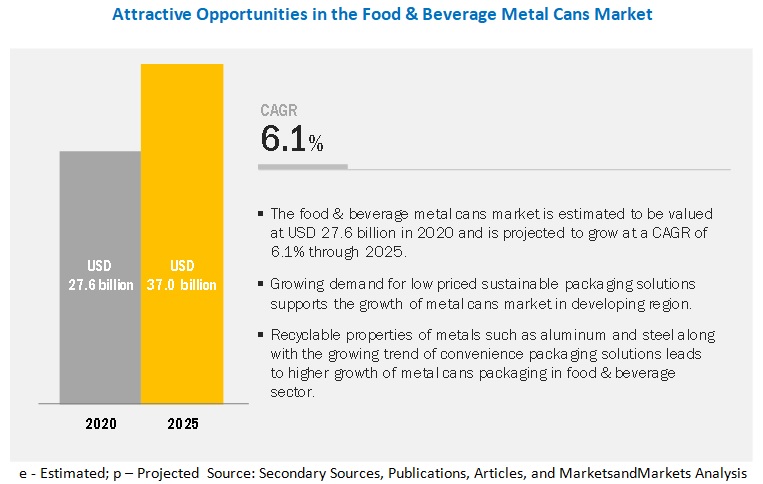According to MarketsandMarkets, the global food & beverage metal cans market is estimated to be valued at USD 27.6 billion in 2020 and is projected to reach USD 37.0 billion by 2025, recording a CAGR of 6.1%. The high recyclable rates of aluminum and the rising number of health-conscious consumers and increasing awareness about healthy nutrients in food & beverages have led to the demand for metal cans. The rise in awareness regarding the drawbacks of using single-use plastics and government intervention in banning the use of such plastics that affect the environment adversely has significantly driven the growth of the metal packaging market for food & beverages.

Report Objectives:
- To describe and forecast the food & beverage metal cans market, in terms of material, type, degree of internal pressure, application, and region
- To describe and forecast the food & beverage metal cans market, in terms of value, by region–Asia Pacific, Europe, North America, South America and the Rest of the World—along with their respective countries
- To provide detailed information regarding the major factors influencing the market growth (drivers, restraints, opportunities, and challenges)
- To strategically analyze micromarkets with respect to individual growth trends, prospects, and contributions to the overall market
- To study the complete value chain of food & beverage metal cans market
Download PDF Brochure: https://www.marketsandmarkets.com/pdfdownloadNew.asp?id=251
By material, the aluminum segment is projected to account for the larger share in the food & beverage metal cans market
The aluminum segment is projected to dominate the market, on the basis of material, during the forecast period. This is attributed to the cost-effectiveness and recycling rates of aluminum. Increasing the use of metal packaging for food & beverages packaging provides a sustainable and environment-friendly solution for packaging in multiple applications. Aluminum cans are convenient to keep in refrigerators and ovens. Changes in consumer preferences are observed for food & beverage packaging. According to the Environmental Protection Agency of the United States (EPA), 1.9 million tons of aluminum packaging was generated for beers and soft drink cans, and 49.2% of aluminum beverage cans were recycled. The metal packaging for the food industry is considered to be safe, which is one of the major factors to support its growth in the market.
By application, the beverages segment accounted for the larger size in the food & beverage metal cans market during the forecast period
Based on the application, the food & beverage metal cans market is segmented into food and beverages. The beverage cans are estimated to account for the larger share, because of the high consumption of carbonated, non-carbonated, and sports & energy drinks. The rise in the consumption of alcoholic beverages leads to the growth of beverage cans market. Moreover, changes in consumer trends toward healthy drinks are driving the market for metal cans during the forecast period.
Make an Inquiry: https://www.marketsandmarkets.com/Enquiry_Before_BuyingNew.asp?id=251
The Asia Pacific region is projected to witness the fastest growth during the forecast period
The Asia Pacific food & beverage metal cans market is projected to have higher growth potential in the coming years. A large consumer market and increasing disposable income in India and China are driving the growth of the demand for high-quality metal packaging. Also, China is the hub for the manufacture of metal cans and has sufficient manufacturing plants to meet the demand for food & beverage metal packaging. Moreover, rapid urbanization in countries such as India and China are expected to result in high growth of the food & beverage metal cans market in Southeast Asia during the forecast period.
This report includes a study on the marketing and development strategies, along with the product portfolios of the leading companies. It consists of the profiles of leading companies such as Crown Holdings, Inc (US), Ball Corporation (US), Silgan Holdings Inc. (US), Ardagh Group (Luxembourg), CAN-PACK S.A. (Poland), Kian Joo Group (Malaysia), CPMC Holdings Limited (China), Huber Packaging Group GmbH (Germany), CCL Industries (US), Toyo Seikan Group Holdings Ltd (Japan), Universal Can Corporation (Japan), Independent Can Company (US), Mauser Packaging Solution LLC (Germany), Visy (Australia), Lageen Food Packaging (Israel), Massilly Holding S.A.S (France), P. Wilkinson Containers Ltd. (UK), Unimpack (Netherlands), Müller und Bauer GmbH (Germany), and Allied Cans (Canada).
